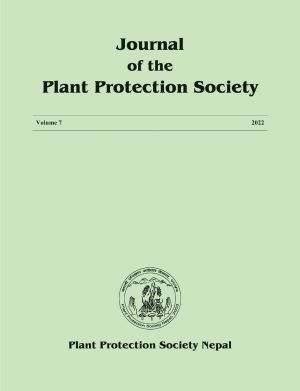Integrated Approaches to Manage Leaf Blast Disease of Rice in Farmer's Field at Godawari, Lalitpur
DOI:
https://doi.org/10.3126/jpps.v7i01.47294Keywords:
Bio-controls, botanicals, disease control, fungicide, leaf blastAbstract
Blast, caused by Pyricularia oryzae is the most important disease of rice (Oryza sativa) in Nepal. With the aim of finding effective control measures against leaf blast disease, an experiment was done in randomized complete block design with three replications in farmer's field at Godawari, during the main seasons of 2018 and 2019. Three plant extracts; commercially available Nimbecidine, leaf extract of Asuro and Titepati, two bio-control agent Trichoderma viride and Kisan Pseudomonas along with one fungicide Kasugamycin were used as treatments. First spray was given as a prophylactic spray at jointing stage and treatments were applied 3 times at 14 days interval. Disease scoring was done according to a 0–9 scale. The result concluded that application of 0.2% Kasugamycin, 2% stock solution of Titepati and 1% Trichoderma viride were produced highest percentage disease control among the treatments by 54.76%, 47.62% and 30.96% respectively. Similarly, 0.2% Kasugamycin, 1% Trichoderma and 2% solution of Titepati treated plot produces the highest yield 5.87 t/ha, 5.49 t/ha and 4.68 t/ha respectively. To reduce leaf blast and higher grain yield of rice, Kasugamycin is the first priority and Titepati is second and for bio control Trichoderma is suggested as alternate approaches.
Downloads
Downloads
Published
How to Cite
Issue
Section
License

This work is licensed under a Creative Commons Attribution-NonCommercial 4.0 International License.
© Plant Protection Society of Nepal

